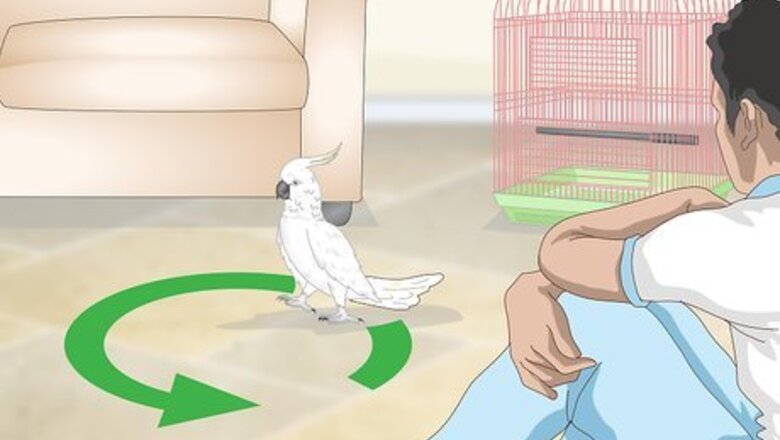
views
Building an Initial Comfort Level

Allow the cockatoo to get used to its surroundings. Do not overwhelm the cockatoo when it first enters your home. Let it roam around, under your supervision, and explore its new surroundings. Keep handling it to a minimum so it has time to hop around and get used to its home. You should also give the cockatoo time to get used to its cage. Make sure its cage is set up before you bring it home. Put toys, perches, food, and water in its cage so it can explore and try out everything on its own.
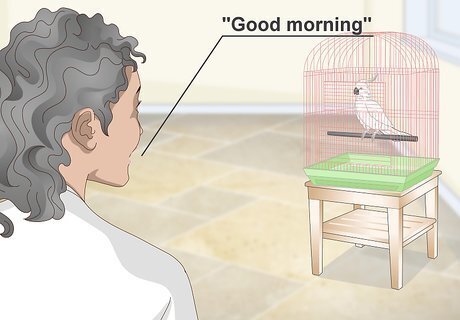
Establish a routine with the cockatoo. Have a standard greeting you say to the bird every morning, such as "Good morning" or "Hello beautiful." Feed the bird at the same time and take it out of its cage for a play session at the same time every day. If you are going to be out for the day, leave the cockatoo in its cage with toys. You can also leave the radio or television on, as cockatoos like hearing voices and music. When you get home, do not rush to see the cockatoo right away. Instead, take a moment to get settled and then greet the cockatoo. This will establish a routine in which the cockatoo is calm and relaxed when you get home.
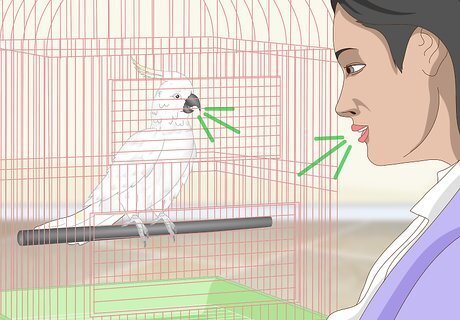
Chat with the cockatoo. Cockatoos love hearing their owner’s voice. Bond with the cockatoo by chatting to it. Use a high, upbeat voice when you chat. It might even try to chat back. For example, you may say to the cockatoo, "Hi there, how are you?" You can also say the cockatoo's name and use your name so it learns your name. You may say, "I'm Sandra, nice to meet you." If your cockatoo is tame enough to be touched, try gently rubbing or scratching the back of its head as you talk to it.

Sing to the cockatoo. Cockatoos respond well to music and singing, especially singing by their owner. You might find a song that the cockatoo likes and sing it every morning or at night before bed to bond with the bird. For example, you may play music for the cockatoo and see which song it responds to. You can then sing the song to the cockatoo to interact and bond with it.
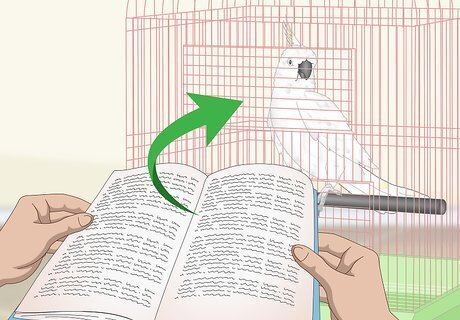
Read to the cockatoo. Another way you can get the cockatoo to bond with your voice by reading aloud to it. Read from the newspaper, a magazine, or a book. Do this once a day so the cockatoo hears your voice and listens to it. Reading to the cockatoo can also help to calm and soothe the bird, especially if it has been riled up by a recent play session.
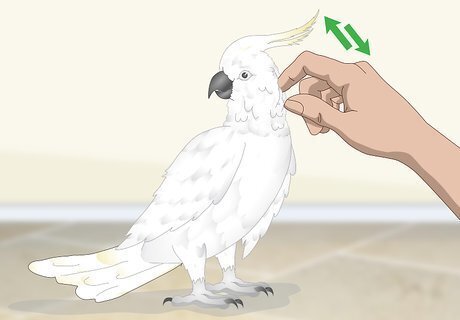
Gently groom your cockatoo. If your cockatoo is not too shy or aggressive to be touched, try grooming it a little while you play or interact. Gently rub or scratch the back of your cockatoo’s head, or pet the areas over its ears or under its beak. Avoid scratching or petting your cockatoo under the wings or near the base of the tail, as your bird may interpret this kind of touch as courtship behavior.
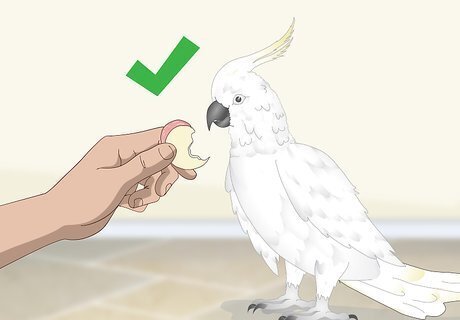
Share food with your cockatoo. If you are eating bird-healthy snacks, such as leafy greens, fresh fruit, or non-sugary breakfast cereal, offer a little bit to your cockatoo. Cockatoos are highly sociable, and enjoy sharing food. You can also “bribe” your bird to cuddle or play with you by offering healthy treats. Avoid giving your cockatoo anything salty or sugary. Never give your cockatoo avocado, chocolate, or alcohol.
Getting the Cockatoo to Perch on Your Hand
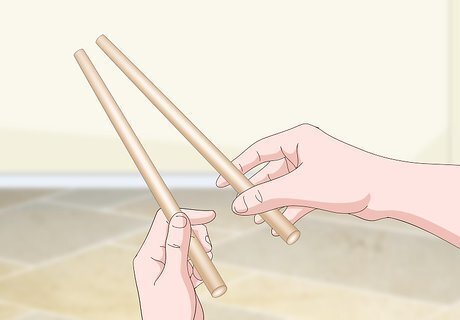
Get two long wooden sticks or dowels. You can get the wooden sticks or dowels at your local pet store or craft store. Look for smooth, thin wooden sticks or dowels, similar to the ones used for a bird’s perch.
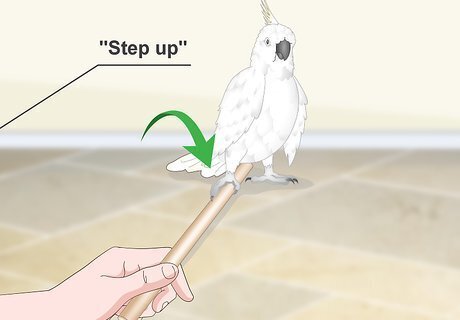
Ask the bird to step on one stick. Say to the cockatoo, “Step up” and hold the stick firmly in your hand. Place the stick in front of the bird. You can also lightly tap the stick with your hand so the bird notices it. If the cockatoo is hesitant, hold a treat in front of the stick so it is motivated to step onto the stick.
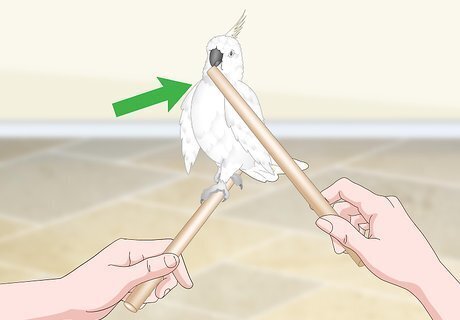
Use the other stick to prevent the bird from biting you. Once the bird gets onto the stick, instruct it to “Stay on the stick.” Hold the other stick out in front of the bird so if it tries to nip at you, you can put the stick in its mouth. This will prevent the bird from biting you while it is perched.
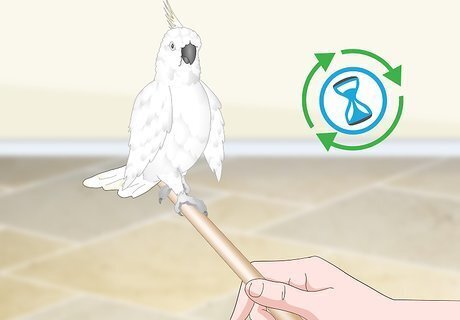
Keep the bird on the stick for several minutes each day. Practice getting the cockatoo on the stick once a day for a few minutes. Always say encouraging things like “Good boy,” “Good girl,” or “Great going” when the cockatoo sits on the stick. Over time the cockatoo should listen to the cue “Step up” and step onto the stick. It should also stop nipping or biting at you as it gets used to the perch.
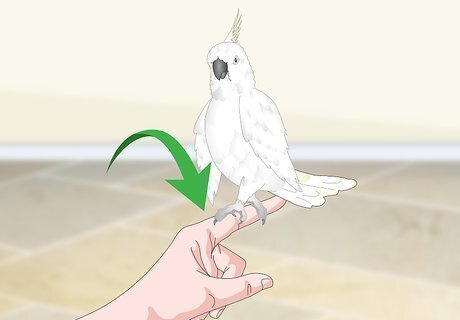
Get the cockatoo to perch on your finger. After you have practiced perching with the sticks for a few weeks, try offering the cockatoo your pointer finger to perch on. By then, you should have built up enough trust so that the bird is willing to step onto your finger. Do this once a day so the cockatoo bonds with you. Make sure you praise the bird after it steps up onto your finger by saying “Great job” or “Good going.”
Teaching the Cockatoo Tricks
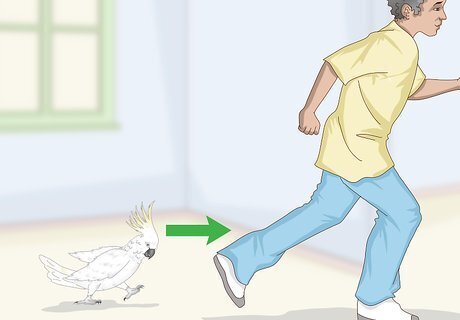
Play chase with the cockatoo. Cockatoos are very high energy and love chasing around their owner. You can play chase by taking the cockatoo out of its cage and placing it on the ground in an open area. Then, start running slowly around the room. The cockatoo should follow you and try to catch you. You can also run after the cockatoo and try to catch it. Playing chase can make the cockatoo very excited. Once you have tired of playing chase, you can get the cockatoo to calm down by placing it back in its cage with a treat or by having it do a trick, like "shake" or "roll the ball."
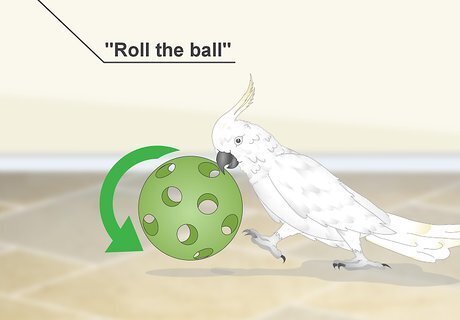
Get the cockatoo to roll a ball. Use a wiffle ball or a small ball made for birds. Show the cockatoo the ball when it is in its cage. Then, roll it towards the cockatoo. Say, “Roll the ball.” The cockatoo should respond by using its beak to roll it back to you. You can then praise it with a treat or by saying “Good job.” You can also teach the cockatoo to play with the ball outside of its cage. Do this on a flat surface. Roll the ball back and forth with the cockatoo to bond with it.
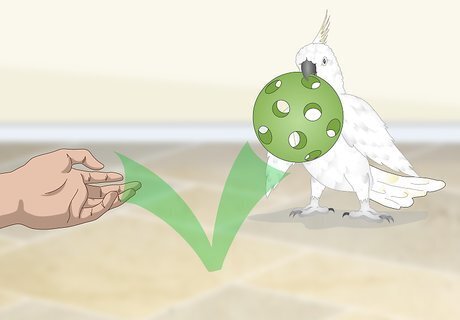
Teach the cockatoo how to catch. Once the cockatoo is comfortable rolling the ball back and forth with you, get it to catch the ball and give it back to you. Say “Catch” and throw the ball towards the cockatoo. The cockatoo should then catch the ball and roll it back to you or try to throw it back. Praise the cockatoo when it throws the ball back to you by saying “Good job” or “Great going.” Be careful not to hit the cockatoo with the ball when you are playing catch. Throw the ball a few inches from the cockatoo and stand close to the cockatoo so it is easy for it to throw it back.
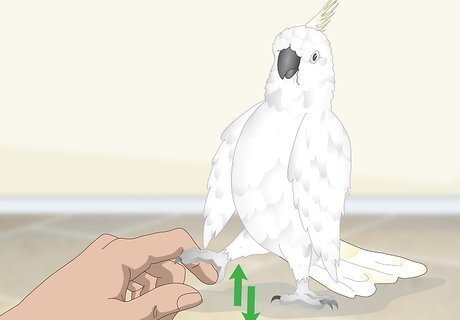
Teach the cockatoo to shake. Make sure your cockatoo is comfortable perching on your hand before you try to teach it this trick. Present your hand to the cockatoo until it lifts its foot to step on it. Say “Shake.” Grip its foot with your fingers like you are shaking its hand. Then, present the cockatoo with a treat and take your hand away. Say “Good job” or “Great going.” Make sure you remove your hand after you have gripped its foot right away so it knows it is doing a “shake,” not a “perch.” Repeat this trick several times for 10 to 15 minutes a day. Your cockatoo should soon learn that “shake” means letting you grip its foot and then letting it go.

Reward the cockatoo with a treat after every trick. Make sure you reinforce each trick by giving the cockatoo a treat. Use bird treats or a piece of fresh fruit. Give the cockatoo 1 treat per trick. Over time, the cockatoo should do tricks without the need for treats.
















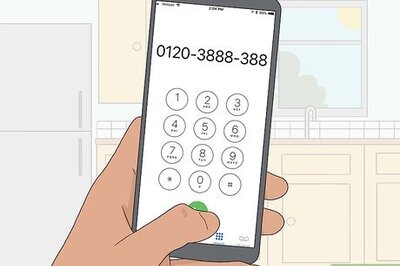

Comments
0 comment